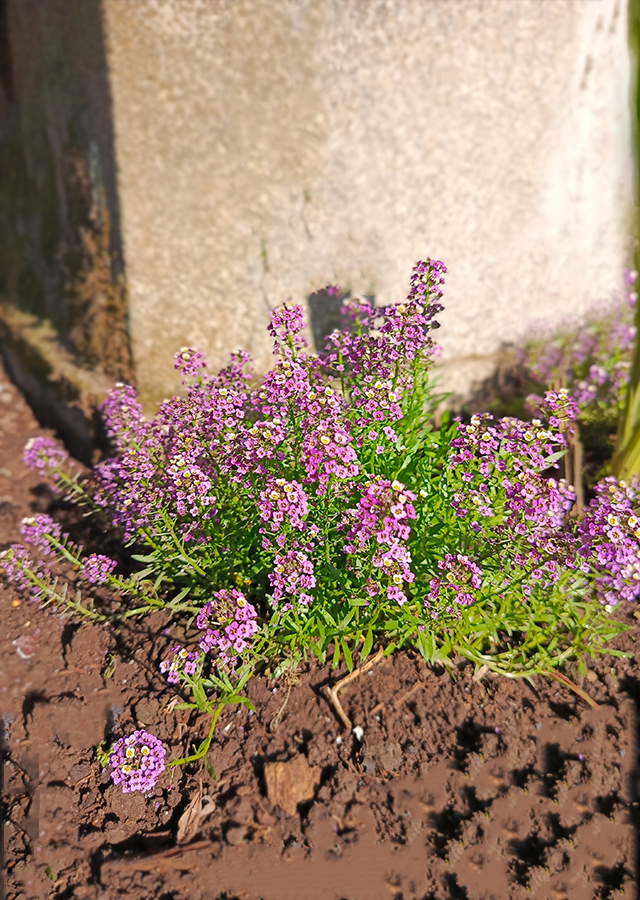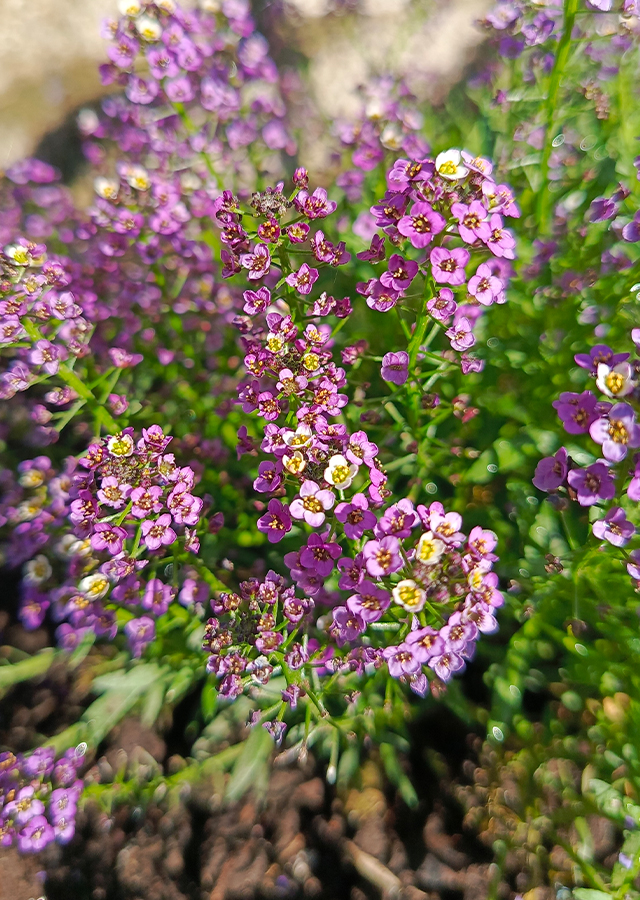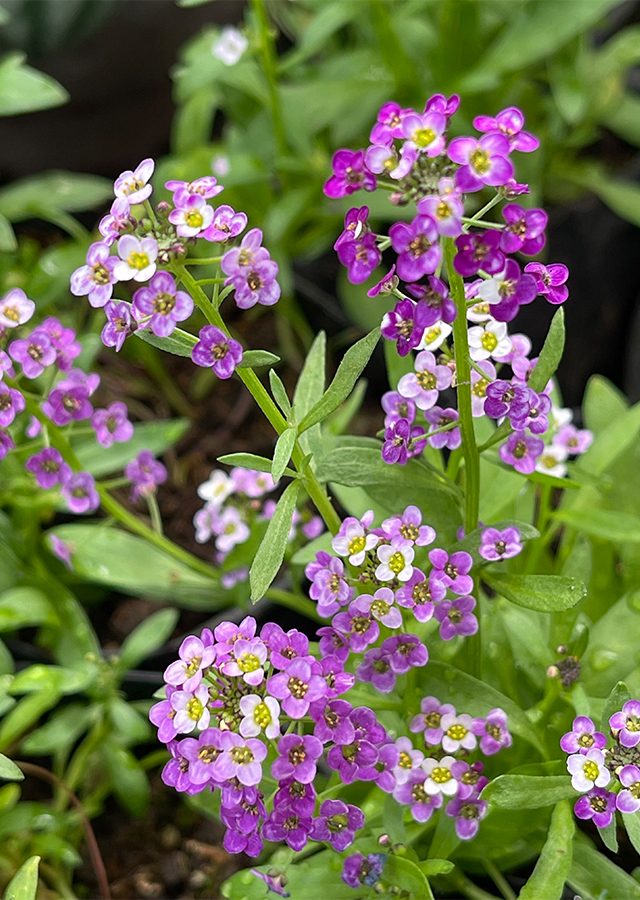Sweet Alyssum
Lobularia maritima (L.) Desv.
Brassicaceae
Location in our garden
Principal



Synonym
Adyseton maritimum (L.) Link
Alyssum maritimum (L.) Lam.
Clypeola maritima L.
Habitus
Herbaceous. An annual/perennial plant, grows up to 0.15 m tall
Part Used
Leaves
Flowers
The Whole Plant
Growing Requirements
Full Sunshine
Drought Resistant
Habitat
Coastal
Roadside
Overview
Alyssum or Lobularia maritima is an annual or short-lived herb, native to the Mediterranean, Canary Islands and Azores, where it grows along the coast in rocky and sunny areas. It was introduced to North America for its drought tolerance, and has also been cultivated in the northern United States. This species is in great demand and widely cultivated as an ornamental plant because of the beauty of its flower shape. Lobularia maritima, usually taken from the wild for local use as a food and medicinal plant. This species is also endemic to Italy and its use as a traditional food source in Southern Italy (Sicily) has been documented. The young leaves, stems and flowers can be used as a flavoring in salads and other dishes that require a spicy taste. Based on its function as a medicinal plant, Lobularia maritima is known to contain various kinds of compounds that can help maintain a healthy body and are believed to be able to relieve various kinds of diseases. However, its use orally for pregnant women is not recommended. Apart from being a food and medicinal plant, this species is also known to produce large amounts of nectar and is an excellent source of various hymenopteran parasitoids.
Vernacular Names
Mastuerzo maritimo (Spanish), Alysson maritime (French), Duft- Steinrich (German), Filograna (Italian), Zeeschildzaad (Dutch).
Agroecology
Alyssum usually grows on roadsides, trash cans, vacant land, agricultural fields, walls, shrubs, sand dunes, coastal zones, especially along the Atlantic, Gulf, Pacific coasts as well as inland, at altitudes ranging from sea level to an altitude of 800 m above sea level. Succeeds in an ordinary garden soil in a sunny position. Grows well on dry walls. Tolerates maritime conditions.
Morphology
- Roots - shallow, low and spreading.
- Stems - branched and many, form clusters of flowers.
- Leaves - alternate, oval to lanceolate without grooves, gray-green.
- Flowers - small and dense, usually white but sometimes pink or lavender, fragrant with a honey-like aroma. The crown (petal) is oval in shape. Stamens 6, glands flanking short oblong filaments. Each flower has 4 crowns (petals). Flowers cluster together in dense terminal heads (racemes).
- Fruits - round flat, often purplish, long, pointed, sparsely hairy.
- Seeds - light brown to reddish, wingless.
Cultivation
Propagated by seeds - it can be sown in situ during mid to late spring and should germinate within 2 weeks. Seedlings can be transplanted.
Chemical Constituents
Linalool, flavonoids (kaempferol, kaempferol‐7‐rhamnoside, kaempferol 3‐glucoside‐7‐rhamnoside, kaempferol‐3‐diglucoside, quercetin‐7‐glucoside, kaempferol 3‐O‐β‐D‐glucopyranosyl‐(1→2)‐ O‐α‐L‐xylopyranoside, and kaempferol 3‐O‐α‐L‐rhamnopyranosyl‐(1→2)‐O‐α‐L‐arabinopyranoside), alkaloids, saponins, tannins, essential oils, and other compounds.
Traditional Medicinal Uses
- The plant is commonly used in Spain as an antiscorbutic and diuretic.
- It is also highly esteemed there as an astringent in the treatment of gonorrhoea.
- Heals wounds faster, relieves headaches, improves and maintains skin health, neutralizes toxins on the skin.
Part Used
Reference Sources
- Temperate Plants Database, Ken Fern. 2021. Lobularia maritima. http://temperate.theferns.info/plant/Lobularia+maritima. 03-06-22.
- Mariangela Marrelli, Maria Pia Argentieri, Pinarosa Avato, and Filomena Conforti. 2020. Lobularia maritima (L.) Desv. Aerial Parts Methanolic Extract: In Vitro Screening of Biological Activity. Plants, 9(89). doi:10.3390/plants9010089.
- Flora of North America. 2020. Lobularia maritima. http://beta.floranorthamerica.org/Lobularia_maritima. 03-06-22.
- Burke Museum Herbarium. 2022. Lobularia maritima. http://biology.burke.washington.edu/herbarium/imagecollection/taxon.php?Taxon=Lobularia%20maritima. 03-06-22.
- CAB International. Lobularia maritima. https://www.cabi.org/isc/datasheet/31373. 03-06-22.


